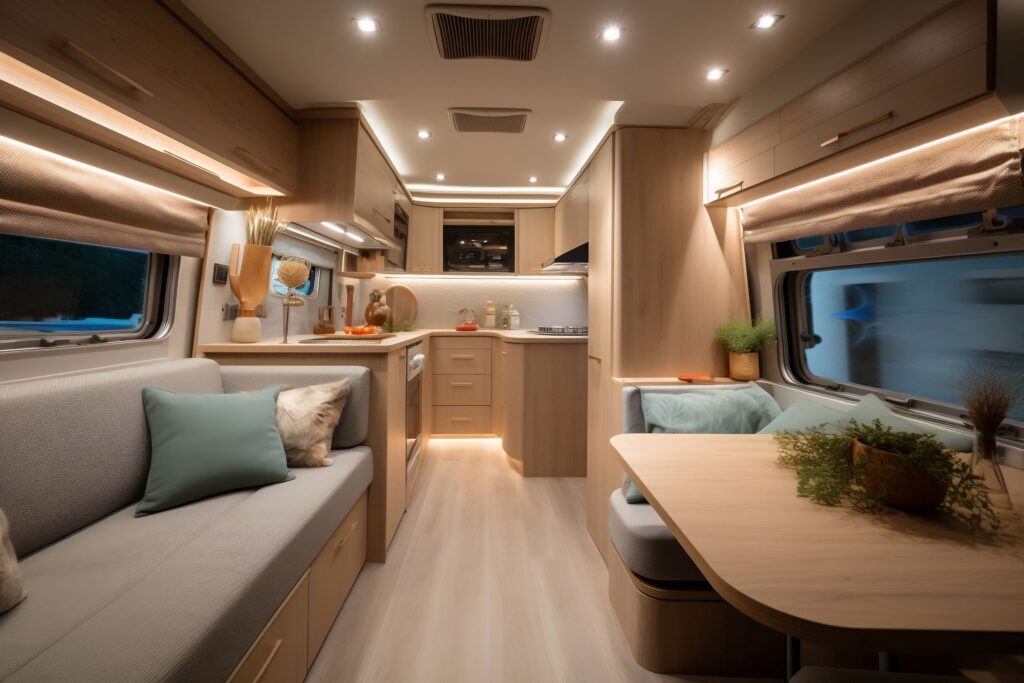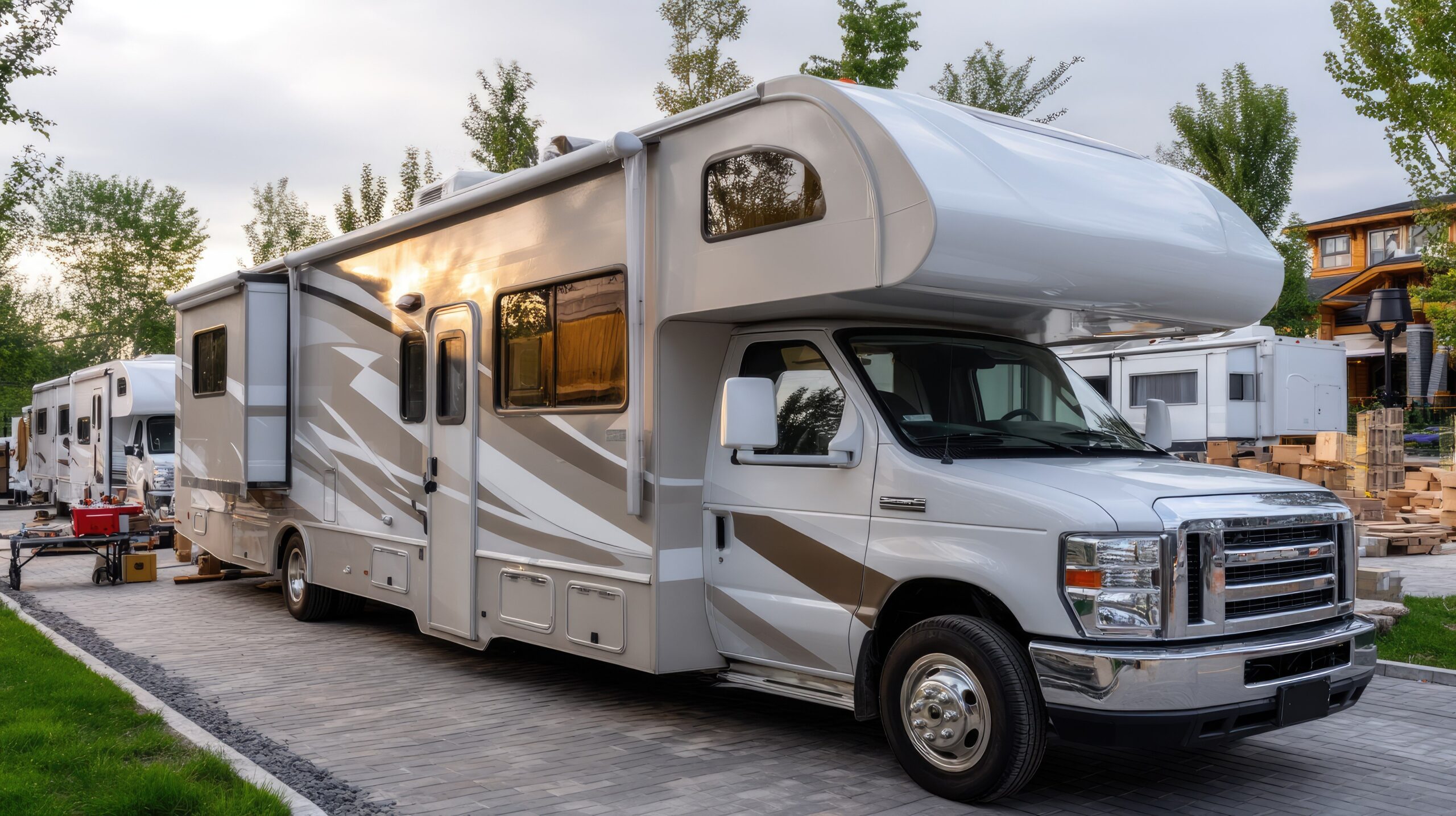1. Humidity and Temperature Fluctuations
Campers are notorious for high humidity levels, especially in regions with wet or humid climates. Unlike traditional homes with HVAC systems, dehumidifiers, and better insulation, campers are small, sealed units that trap moisture. Cooking, showering, breathing, and even rainy days introduce moisture that has nowhere to go.
Condensation frequently forms on windows, walls, and ceilings, especially during cool nights followed by warmer days. Over time, this persistent dampness leads to mold growth behind walls, under flooring, and inside cabinets—all hidden from plain sight.
2. Water Intrusion from Leaks
Another major risk factor is water intrusion, which is rampant in aging or poorly maintained campers. Leaky roofs, seals, vents, or window frames can allow rainwater and snowmelt to seep into the walls, providing the moisture mold spores need to flourish.
Many owners don’t realize that even a small leak—left unaddressed—can saturate wood and insulation, leading to black mold outbreaks that compromise air quality and structural integrity.
3. Limited Air Circulation and Fresh Air Exchange
Modern homes are built with ventilation codes that support regular air exchange. Campers, however, lack mechanical ventilation systems. Most rely on passive vents or windows that only get opened seasonally. This stagnant environment fosters high mold spore concentrations, especially when doors and windows are shut for long periods.
Mold thrives in darkness, moisture, and still air—conditions commonly found inside unused or stored campers.

Chemical Exposure: Formaldehyde and VOCs in Camper Construction
1. Pressed Wood and Particleboard Off-Gassing
Most campers are constructed using affordable, lightweight building materials such as particleboard, plywood, MDF (medium-density fiberboard), and laminated cabinetry. These are all held together using formaldehyde-based adhesives. Formaldehyde is a known human carcinogen and can off-gas for years after installation.
According to the EPA, formaldehyde exposure can cause:
- Burning sensations in the eyes, nose, and throat
- Respiratory issues and asthma attacks
- Skin irritation
- Long-term cancer risk with chronic exposure
Unfortunately, in campers, the concentration of these off-gassed chemicals is higher than in homes due to limited air volume and poor ventilation.
2. VOCs from Glues, Paints, Sealants, and Furnishings
In addition to formaldehyde, campers contain a cocktail of volatile organic compounds (VOCs) emitted from:
- Flooring adhesives
- Paint and caulk
- Upholstery, curtains, and mattresses
- Cleaning agents and air fresheners
These VOCs combine with heat and humidity to create an even more toxic brew. Many owners notice that during warm months or after leaving the camper closed up, there’s a distinct chemical odor upon entering—a clear sign of concentrated indoor air pollution.
3. New Camper Syndrome
Just like “new car smell,” new campers often smell fresh and clean. But in reality, this scent is the result of off-gassed formaldehyde, benzene, and other VOCs. This is commonly referred to as New Camper Syndrome and can cause headaches, dizziness, nausea, and brain fog—especially among children, seniors, and individuals with sensitivities.
Why Occupancy and Seasonal Use Make Things Worse
1. People Add Moisture
Each person contributes roughly one liter of water vapor per day just by breathing. Add in showers, cooking, and dishwashing, and a family of four can introduce 5–10 liters of water vapor into a small camper each day. Without ventilation, this moisture builds up rapidly—leading to fogged windows, damp bedding, and eventually, hidden mold.
2. Off-Gassing Increases with Heat
During hot months, campers act like greenhouses. Closed-up units sitting in the sun can reach indoor temperatures above 120°F, accelerating the off-gassing of VOCs and formaldehyde from furniture and building materials. The warmer it gets, the more chemicals are released into the air.
3. Small Space, Higher Concentration
Campers generally have less than 300 square feet of living space. When multiple people are inside, carbon dioxide levels, body heat, and VOC concentrations skyrocket. Unlike homes, campers can’t rely on air exchange systems to dilute these pollutants—meaning air quality deteriorates with every additional occupant.

Common Health Symptoms Linked to Poor Air Quality in Campers
Mold and chemical exposure in campers can cause a wide range of health symptoms, including:
- Coughing, wheezing, and chest tightness
- Sinus infections and nasal congestion
- Skin rashes or hives
- Brain fog, fatigue, and headaches
- Eye, nose, and throat irritation
- Nausea or dizziness
- Worsening of asthma and allergies
These symptoms often go undiagnosed because they’re mistaken for seasonal allergies, colds, or travel fatigue. However, the moment symptoms improve outside the camper, it becomes clear: indoor air quality is the root cause.
The Case for On-Demand Mold and Chemical Testing in Campers
1. Mold Is Often Hidden
By the time you see mold on a wall or ceiling, the infestation may already be widespread behind walls, inside cabinets, and under flooring. Testing the air for spores and mycotoxins is the only reliable way to uncover hidden contamination.
2. Formaldehyde and VOCs Have No Odor Threshold
Even if your camper smells “normal,” it could still harbor dangerous chemical levels. Air testing reveals exact concentrations of formaldehyde, benzene, toluene, and other pollutants—data that helps you make informed decisions about remediation or avoidance.
3. Avoid Guesswork. Get Science.
DIY mold kits and consumer-grade chemical sensors often fail to provide accurate, reproducible data. That’s why IndoorDoctor developed its On-Demand Mold and Chemical Testing Service—an affordable, science-backed solution to camper air quality concerns.
How IndoorDoctor’s On-Demand Testing Works
✅ Delivered to Your Door – Get a professional air sampling kit shipped directly to your location.
✅ Simple Instructions – Easy step-by-step guidance ensures accurate sampling, even with no prior experience.
✅ Lab-Verified Results – Samples are returned to an accredited laboratory for detailed analysis of mold spores, formaldehyde levels, and VOCs.
✅ Expert Consultation – Your results are reviewed by certified Indoor Environmental Professionals (IEPs) who offer actionable insights and recommendations.
✅ Peace of Mind – Whether you’re full-timing in your camper or storing it for the season, you’ll know exactly what’s in your air—and what to do about it.
Call to Action: Protect Your Health with IndoorDoctor’s On-Demand Air Quality Testing
Don’t wait for musty odors, water stains, or mysterious health symptoms to appear. Campers are uniquely vulnerable to hidden mold and chemical exposure, and most of the risks are completely invisible.
Whether you’re a weekend adventurer, a seasonal traveler, or a full-time RV dweller, the air you breathe matters. With IndoorDoctor’s On-Demand Air Quality Testing, you can take control of your indoor environment—quickly, affordably, and with confidence.
👉 Order your On-Demand Testing Kit today:
https://www.indoordoctor.com/on-demand-air-quality-testing/
Combat Camper Contaminants with a Medical-Grade Air Purifier
Even after mold remediation or chemical source removal, indoor air quality often remains compromised due to persistent off-gassing and residual spores in tight camper environments. That’s why many RV owners turn to medical-grade air purification as a proactive step toward ongoing protection.
The Austin Air HealthMate Jr. Plus: Your Best Defense on the Road
The Austin Air HealthMate Jr. Plus is one of the most trusted and effective portable purifiers for campers and small living spaces. Designed with a specialized blend of activated carbon, zeolite, and true HEPA filtration, it excels at removing:
- Airborne mold spores and allergens
- Formaldehyde and VOCs off-gassed from camper construction materials
- Chemical odors, gases, and pollutants from indoor sources
This unit is a top recommendation for those with chemical sensitivities, allergies, asthma, or compromised immune systems. It’s compact enough to fit comfortably inside your camper, yet powerful enough to continuously scrub your air clean—even when the camper is sealed or in storage.
Combat Camper Contaminants with a Medical-Grade Air Purifier
Even after mold remediation or chemical source removal, indoor air quality often remains compromised due to persistent off-gassing and residual spores in tight camper environments. That’s why many RV owners turn to medical-grade air purification as a proactive step toward ongoing protection.
The Austin Air HealthMate Jr. Plus: Your Best Defense on the Road
The Austin Air HealthMate Jr. Plus is one of the most trusted and effective portable purifiers for campers and small living spaces. Designed with a specialized blend of activated carbon, zeolite, and true HEPA filtration, it excels at removing:
- Airborne mold spores and allergens
- Formaldehyde and VOCs off-gassed from camper construction materials
- Chemical odors, gases, and pollutants from indoor sources
This unit is a top recommendation for those with chemical sensitivities, allergies, asthma, or compromised immune systems. It’s compact enough to fit comfortably inside your camper, yet powerful enough to continuously scrub your air clean—even when the camper is sealed or in storage.
Whether you’re living in your camper full-time or just want cleaner air during weekend getaways, the HealthMate Jr. Plus offers reliable, long-term protection from the most dangerous airborne contaminants found in RV environments.
👉 Order yours today and breathe easier in your camper:
https://www.indoordoctor.com/product/healthmate-plus-jr/
Your lungs—and your loved ones—will thank you.
References
- Environmental Protection Agency. Formaldehyde in Your Home: What You Need to Know
- U.S. Department of Housing and Urban Development. Manufactured Home Construction and Safety Standards
- Agency for Toxic Substances and Disease Registry. Toxicological Profile for Formaldehyde
- American Industrial Hygiene Association. Volatile Organic Compounds: Sources and Health Effects
- IndoorDoctor. On-Demand Air Quality Testing for Mold and Chemicals



